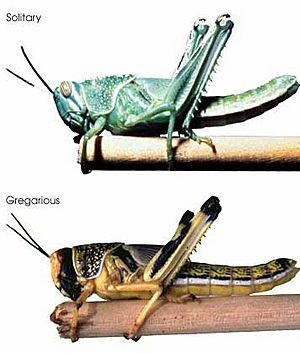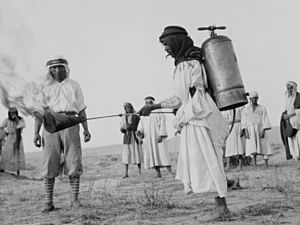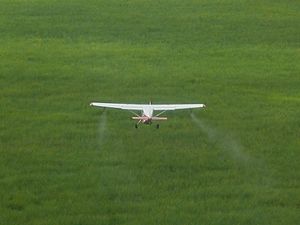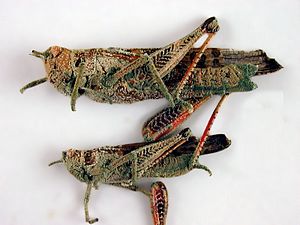Locust facts for kids
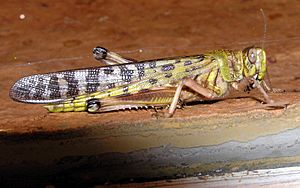
Locusts are a special type of grasshopper. They are known for forming huge groups called swarms. These swarms can have billions of locusts. When they fly together, they eat almost all the green plants and crops in their path. This causes a lot of damage to farms.
Locusts can multiply very quickly when conditions are right. A good example is the migratory locust. When there are many of them, they start to act differently. They become social and travel together. Young locusts, called nymphs, form groups called bands. Adult locusts form even bigger groups called swarms. Both bands and swarms move around a lot and can quickly destroy fields. Adult locusts are strong fliers. They can travel very far, eating all the plants wherever they land.
Some types of locusts have become extinct. It's not always clear why. Some of these ancient locusts could grow quite large, up to about 15 centimeters (6 inches) long.
People in some countries eat locusts. They are seen as a special food. Eating insects is called entomophagy. There are stories about people eating locusts throughout history.
Contents
What Makes a Grasshopper a Locust?
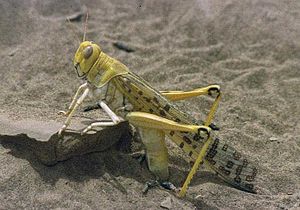
Locusts are actually certain kinds of short-horned grasshoppers. They belong to the family called Acrididae. Usually, these insects live alone. But sometimes, when there are many of them, they change their behavior. They become very social and group together.
There isn't a separate scientific name for locusts compared to grasshoppers. The difference is how they behave. We call a grasshopper a "locust" if it changes its body and behavior when it gets crowded. These changes lead to them forming large swarms. The young locusts, called hoppers, form bands.
These changes are a type of polymorphism. This means an animal can have different forms. A scientist named Boris Uvarov first studied these changes. He found that the desert locust had two forms: a solitary one and a gregarious (social) one. He called them solitaria and gregaria. The social locusts are also called migratory forms because they travel in swarms.
How Swarming Happens
Swarming happens when there are too many locusts in one place. If a locust's back legs are touched often, it causes a chemical called serotonin to increase in its body. This makes the locust change color, eat much more, and lay more eggs. Just a few touches per minute over four hours can start this change.
A very large swarm can cover thousands of square kilometers. It can have billions of locusts. There might be up to 80 million locusts in just one square kilometer. When desert locusts meet, their bodies release serotonin. This makes them attracted to each other, which is the first step to forming a swarm.
Small groups of social hoppers are called "outbreaks." When these outbreaks join together, it's called an "upsurge." If many upsurges happen in a large area from different breeding spots, it's called a "plague." During a plague, the number of locusts can grow very fast. For example, a desert locust plague in Africa, the Middle East, and Asia from 1966 to 1969 saw locust numbers jump from 2 billion to 30 billion in just two generations.
Solitary and Gregarious Phases
One of the biggest differences between solitary and social locusts is how they act. Young social locusts (gregaria nymphs) are drawn to each other. They start forming bands of thousands of insects very early on. These groups move together like one big unit. They usually go downhill, moving around obstacles and joining other bands.
Locusts seem to be attracted to each other mostly by sight. They also use smells to find each other. The bands use the sun to find their way. They stop to eat sometimes, then continue their march. They can travel tens of kilometers in a few weeks.
Their bodies also change. For example, in the desert locust, the social nymphs become darker. They have strong yellow and black patterns. They grow bigger and take longer to develop. Adult social locusts are larger and have different body shapes. They also have a faster metabolic rate. They grow up and start laying eggs sooner, but they lay fewer eggs overall.
Adult locusts also stay attracted to each other. They continue to act as a group. If a locust gets separated from the swarm, it flies back to the main group. If some are left behind after eating, they fly to rejoin the swarm when it passes overhead. The swarm often moves like a rolling wave. Locusts at the front land to eat, and others fly over them to land further ahead. They spend a lot of time on the ground eating and resting. They move on when there's no more food. Then they might fly far away to a place where rain has caused new plants to grow.
Where Locusts Live
Several types of grasshoppers become locusts and swarm in different parts of the world. They are found on all continents except Antarctica and North America. For example, the Australian plague locust swarms across Australia.
The desert locust (Schistocerca gregaria) is probably the most famous. It lives in North Africa, the Middle East, and Indian subcontinent. It can also migrate over very long distances. In 2003-2004, a huge outbreak covered much of western Africa. This happened after a lot of rain created good conditions for swarming. The cost to control this outbreak was about US$122 million. The damage to crops was up to $2.5 billion.
The migratory locust (Locusta migratoria) is found in Africa, Asia, Australia, and New Zealand. It used to be common in Europe but is rare there now. In 2013, the migratory locust in Madagascar formed swarms with over a billion insects. This became a "plague" and covered about half the country.
Locusts and People
Locusts in History
History books show how common locust plagues were. These insects would appear suddenly, often when the wind or weather changed. The results were terrible. Ancient Egyptians carved locusts on tombs between 2470 and 2220 BC. The Bible, in the Book of Exodus, talks about a terrible plague of locusts in Egypt around 1300 BC. The Iliad also mentions locusts flying away from fire. The Quran also talks about locust plagues. In China, in the 800s BC, special officers were appointed to deal with locusts.
The ancient Greek thinker Aristotle studied locusts. The Roman historian Livy wrote about a huge plague in Capua in 203 BC. He said that human diseases often followed locust plagues. He thought this was because of the bad smell from dead locusts. People often believed that locust plagues caused human sickness. For example, a sickness in China in 311 AD killed 98% of people in one area. People blamed locusts, but it might have been caused by more rats and their fleas eating the dead locusts.
Controlling Locusts
For a long time, people could do little to protect their crops from locusts. Eating the insects might have been the only comfort. By the early 1900s, people started trying to stop locusts from growing. They would dig up soil where eggs were laid. They used machines to catch young locusts. They even used flamethrowers, trapped them in ditches, or crushed them.
In more recent times, when locust control is needed, young locusts are targeted in spring. Workers spray water-based pesticides using tractors. This works but is slow. It's often better to spray concentrated insecticides from airplanes over the locusts or the plants they eat. Using planes to spray large areas quickly is very effective against moving bands of locusts. Modern tools like GPS, GIS, and satellite imagery help plan where to spray. Computers help manage and analyze all the information quickly.
In 1997, a new way to control locusts was tested in Africa. It uses a biological pesticide. This pesticide contains dried spores of a fungus called Metarhizium acridum. When sprayed in breeding areas, the fungus spores grow and enter the locust's body, killing it. The fungus can spread from one locust to another and stays in the area. This means you don't need to spray as often. This method was used in Tanzania in 2009 to treat about 10,000 hectares of land. The locust outbreak was stopped, and animals like elephants, hippopotamuses, and giraffes in the park were not harmed.
The main goal of locust control is to use methods that prevent outbreaks and cause the least harm to the environment. This helps farmers grow crops more safely in areas where food is very important for people to survive.
Locusts as Food
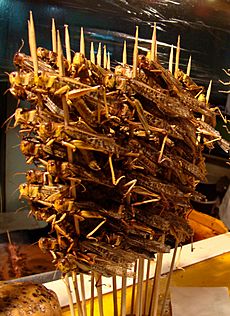
Many cultures around the world eat insects. Locusts are seen as a special food in many African, Middle Eastern, and Asian countries. They have been eaten throughout history.
Locusts can be cooked in many ways. They are often fried, smoked, or dried. The Bible says that John the Baptist ate locusts and wild honey when he lived in the desert.
The Torah, which is part of the Jewish holy texts, allows eating certain types of locusts. In Islamic law, eating locusts is considered halal, meaning it is allowed. The Prophet Muhammad was said to have eaten locusts with his friends during a military trip.
Locusts are eaten in the Arabian Peninsula, including Saudi Arabia and Kuwait. In 2014, many Saudis ate more locusts around Ramadan, especially in the Al-Qassim Region. They believed locusts were healthy. However, the Saudi Ministry of Health warned that pesticides used against locusts made them unsafe to eat. People in Yemen also eat locusts.
Locusts are a good source of protein. They provide about five times more edible protein than cattle for the same amount of food they eat. They also produce less greenhouse gases. A 100-gram serving of desert locusts has about 11.5 grams of fat, with more than half being healthy unsaturated fats. They also contain minerals like potassium, sodium, phosphorus, calcium, magnesium, iron, and zinc.
Related pages
Images for kids
-
Locusts are grasshoppers, like this migratory locust, that enter a special traveling phase of their life.
-
A Garden locust (Acanthacris ruficornis) in Ghana.
-
Millions of swarming Australian plague locusts moving together.
-
Eugenio Morales Agacino on an expedition to monitor locusts in the desert of Spanish Sahara, 1942.
See also
 In Spanish: Langosta (insecto) para niños
In Spanish: Langosta (insecto) para niños


